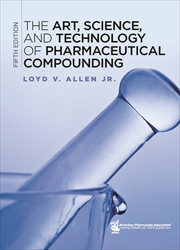|
|
| Letter from the Editor |
| News |
| IJPC now on Facebook and Youtube |
| Did You Know? |
| Tip of the Week |
| Looking Back |
| Announcement |
|
| |
|
|
| Info@CompoundingToday.com or (800) 757-4572 ext 1 |
| |
|
|
| To place a classified advertisement please contact: Lauren Bernick lbernick@ijpc.com or (405) 513-4236 |
| |
|
|
|
|
| |
|
|
|
|
| |
|
|
|
|
|
|
|
 |
| |
 | |  |
| Implementing United States Pharmacopeia <800>, Part 20: Hazardous Drugs-Handling in Healthcare Settings |
|
| |
|
(Learning about USP Chapter <800> in 10 minutes a week.)
15. DEACTIVATING, DECONTAMINATING, CLEANING, AND DISINFECTING
Nonsterile Areas: Deactivation, Decontamination, Cleaning
Sterile Areas: Deactivation, Decontamination, Cleaning, Disinfection
- SOPs needed
- Training required
- Appropriate PPE resistant to cleaning agents used must be worn, including two pairs of chemo gloves and impermeable disposable gowns
- Eye protection and face shields required if splashing is likely
- Respiratory protection if warranted
- Use wetted wipes and not spray bottle for surfaces
- Dispose of materials properly
15.1 Deactivation
- Render compound inert or inactive
- No single method for deactivating all compounds
- Oxidizing agents generally used
15.2 Decontamination
- Remove HD residue
- Inactivate, neutralize, or physically remove the HD residue
- Includes work surface and under the "work trays" where residue may collect
15.3 Cleaning
- Remove organic and inorganic material
- Uses water, detergents, surfactants, solvents, and/or other chemicals
- Not to be performed with compounding activities are occurring
15.4 Disinfection
- Destroy microorganisms
- Required for surfaces where sterile compounding occurs
QUESTIONS
For a full list of questions for which we are awaiting answers from USP, please go to: http://www.ijpc.com/USP800Questions
We will announce when the answers have been received and posted.
Loyd V. Allen, Jr., PhD, RPh
Editor-in-Chief
International Journal of Pharmaceutical Compounding
Remington: The Science and Practice of Pharmacy Twenty-second edition
|
| |
|
News
FDA Requests Cabinet-level Powers
Six former FDA commissioners have called upon Congress to make the agency independent, increasing its profile and power, and taking it out from under DHHS. They are requesting autonomy similar to the FTC or the Securities and Exchange Commission.
See http://www.politico.com/story/2016/06/former-commissioners-make-fda-a-cabinet-level-agency-224803
(Editor's note: You've got to be kidding! Definitely a bad idea for healthcare professionals and patients.)
|
| |
|
IJPC Now on Facebook and Youtube
Become a fan of the IJPC Facebook page and share ideas, photos, and keep up to date with the latest compounding information - http://www.facebook.com/IJPCompounding
Learn about the Journal's new multi-media features and view our growing collection of educational and training videos at www.ijpc.com/video or by subscribing to our Youtube channel at https://www.youtube.com/user/IJPCompounding.
|
| |
|
Did You Know ...
�that standard drug concentrations for compounded oral liquids have been voluntarily developed for pediatric patients in the state of Michigan?
|
| |
|
Tip of the Week
Respondents to a survey on the new standard drug concentrations indicated they believe the standards will improve pediatric patient safety, and 48% of pharmacists reported that they had adopted at least 50% of the standard concentrations. [AJHP 2016; 73(13): 981-990].
|
| |
|
Looking Back
The cream preserves
Pa's razor blade,
The jar preserves
Ma's marmalade!
Burma Shave
|
| |
|
ANNOUNCEMENT-JUST RELEASED!
Save 20% on the latest edition of The Art, Science, and Technology of Pharmaceutical Compounding, 5th Edition
The Art, Science, and Technology of Pharmaceutical Compounding presents in a logical and progressive format all the information that pharmacists and student pharmacists need to understand about the purpose and processes of compounding. In this 5th edition:

- All chapters have been updated
- Several chapters have been significantly revised-particularly "Compounding with Hazardous Drugs", and
- Three new chapters have been added:
- "Pharmaceutical Compounding Errors,"
- "Foams," and
- "Compounding with Special Ingredients"
Information on the new law affecting compounding, the Drug Quality and Security Act, is incorporated throughout the book. Chapter 14 now includes information on compounding "films."
Purchase your copy by July 8 and save 20% off of the list price ($99.95). APhA members will receive an additional 20% off of the standard member price ($79.95). To take advantage of this offer, visit Pharmacist.com shop and add The Art, Science, and Technology of Pharmaceutical Compounding to your shopping cart. During checkout apply promo code AST2016 to receive your 20% discount.
Hurry, offer ends 7/8/2016!
|
|